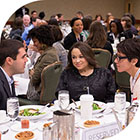In late 2013, Independent Sector's 2013 American Express NGen Fellows (NGen Fellows) selected the National Audubon Society (Audubon) for a pro bono project focused on strategies for talent diversity, a core issue faced by the nonprofit sector. Audubon has encountered challenges in attracting, retaining, and advancing leadership of color, and we provide a valuable case study that could benefit organizations across the sector.
Our mission includes addressing climate change, habitat destruction, and environmental degradation—all issues that disproportionately affect certain human communities, including some communities of color. Multiple surveys reveal that communities of color care very deeply about these issues; to better reach and serve these constituents, we need to better reflect them in our ranks. While Audubon had made meaningful progress in some areas of diversity, including gender, age, and sexual orientation, our staff remained 88 percent white.
To help reach our goals around diversity, Audubon CEO David Yarnold has made building a diverse, inclusive workforce a priority. He has defined diversity in the workforce to include race, color, religion, sex, age, sexual orientation, gender identity and expression, disability, national or ethnic origin, politics, and veteran status. What's more, Audubon's 2012-2015 strategic plan clearly states the diversity imperative: "[Our] strategic plan recognizes that reaching a broader and more diverse audience is critical to building a more effective, transformational Audubon."
To help us make more progress, the NGen Fellows were asked to research the issue; highlight opportunities for Audubon; identify success stories in increasing workforce diversity; and cast a critical eye on our existing efforts. (While diversity includes numerous factors, the team specifically focused on racial and cultural diversity for this project.)
Understanding Challenges and Opportunities
 2013 Independent Sector NGen Fellows Dan Dobin (Bridgespan), Terri Williams (American Heart Association), and Carmen Rojas (The Workers Lab) discuss their project on strategic talent diversity.
2013 Independent Sector NGen Fellows Dan Dobin (Bridgespan), Terri Williams (American Heart Association), and Carmen Rojas (The Workers Lab) discuss their project on strategic talent diversity.Over four months the NGen Fellows reviewed internal documents and interviewed staff at national and state offices to better understand Audubon's structure and culture. The team also gathered best practices through both a review of existing research focused on staff diversity, and interviews with independent experts and other organizations that have successfully increased diversity in their fields. Our research surfaced five key opportunities for Audubon:
1. Tap into a larger, more diverse talent pool
2. Build diverse staff, management, and boards across state programs
Each local Audubon state office and program is responsible for selecting staff, management, and board members. Headquarters should consider investing in recruitment resources that support these efforts both nationally and locally. This could include setting diversity goals in applicant pools; creating local/national recruiting partnerships; and considering volunteers as a pipeline for staff.
3. Keep and develop existing staff
Audubon is in the early stages of developing a network-wide strategy for professional development and career growth. Employee interviews surfaced opportunities to improve retention, including stated goals and benchmarks around recruitment and retention of diverse staff members, as well as targeted leadership development programs that support the growth of a diverse staff. We also can explore mentoring opportunities to support younger people of color. Our Washington state program has made this a priority by building a diverse board comprised of individuals with community connections and the ability to serve as mentors for recently hired staff.
 An Audubon educator provides environmental education to a group of public school and homeschooled children at the Lake Region Audubon Society on April 26, 2013. Photo: Reinier Munguia
An Audubon educator provides environmental education to a group of public school and homeschooled children at the Lake Region Audubon Society on April 26, 2013. Photo: Reinier Munguia4. Promote a culture of and build capabilities around diversity and inclusion
Audubon can do more to articulate the value of diversity and inclusion to our network. A clear and compelling business case that responds to the interests of the network's stakeholders (e.g., staff, donors, community partners, etc.) would provide an important foundation for designing strategies, identifying priorities, and measuring results. In addition, we should build capabilities through training and replication of best practices. One local staff member shared, "We would benefit from seeing how others in the Audubon network are increasing diversity." Another suggested, "If we train staff members on diversity and sensitivity, then staff members will be more educated in these matters and be able to then develop their own ideas that they can apply to their regions."
5. Strengthen engagement with communities of color to generate trust
We should identify local programs that are effectively engaging diverse communities and replicate them where relevant throughout our network. A staff member from Audubon's Louisiana state program shared, "Programs like Grow Dat and other urban farm programs have been a powerful vehicle for Audubon to engage with youth and communities of color since the urban farm movement is growing nationally. If we invest more in programs like this, we are bound to start changing the perception that others have toward us as a bird-watching group."
Implementing Change
The NGen Fellows' recommendations reinforced much of what we knew and suspected, and helped move us toward improvement. Since the report's completion in June 2014, we have implemented and reinforced many of the recommendations.
- We've broadened our recruitment sources, which is helping us present people of color for positions throughout the organization at all levels. We've also improved the diversity of our intern program, where we've gone from 10 percent people of color to 30 percent.
- In almost every Audubon staff meeting, town hall, or CEO communication, we include mention of diversity—a successful community program, outreach, key hires—in a way that focuses on the successes of our efforts. We also rewrote Audubon's diversity and inclusion policy to make a stronger business case for diversity. An excerpt:
"Diversity and inclusion is not only a best practice for business, it's a strategic imperative. Our business and conservation strategies are enriched and made stronger by the contribution of the experiences, perspectives, and values of diverse individuals and communities. Protecting and conserving nature and the environment transcends political, cultural, and social boundaries, and so must Audubon in order to expand our network's reach and engage more people in protecting birds and habitat." - Audubon gathered 25 leaders from across the organization for our first Diversity and Inclusion workshop last August. The workshop infused our network with diversity champions: each of the participants left the workshop energized and equipped with training, a network of contacts, and support from headquarters to implement projects that will engage a wide variety of communities.
- Through our chapters and state offices, Audubon has increased outreach efforts to more diverse communities. Our Bird-Friendly Communities initiative is worthy of mention, as is the Toyota TogetherGreen program. This ongoing, seven-year partnership supports innovative, community-based conservation projects that actively engage new audiences.
Moving Forward
While factors like organizational size, life stage, and issue area will ultimately determine which strategies are most relevant to an organization, the learnings from the NGen Fellows' research and Audubon's experience will hopefully inspire a collective effort to create a more inclusive environment across the nonprofit sector. The NGen Fellows' report, Strategies for Talent Diversity, contains suggested criteria and assessment tools to help organizations get started in identifying and assessing their own strategies for increasing diversity. The nonprofit sector has shown its capacity for transformational change; increasing diversity holds the potential to increase this capacity so organizations can find new and better ways to improve lives and generate impact across all populations.
Peter Vincent is vice president of Human Resources at the National Audubon Society, a nonprofit dedicated to conserving and restoring natural ecosystems. He worked closely with colleagues and the NGen Fellows team to understand diversity challenges and opportunities at Audubon during the strategic talent diversity project.
Monisha Kapila is founder and CEO of ProInspire, a nonprofit that develops leaders at all levels for organizations addressing the world's greatest challenges. She is a member of the NGen Fellows team that researched and wrote the report, Strategies for Talent Diversity. Follow her on Twitter: @monishakapila.


